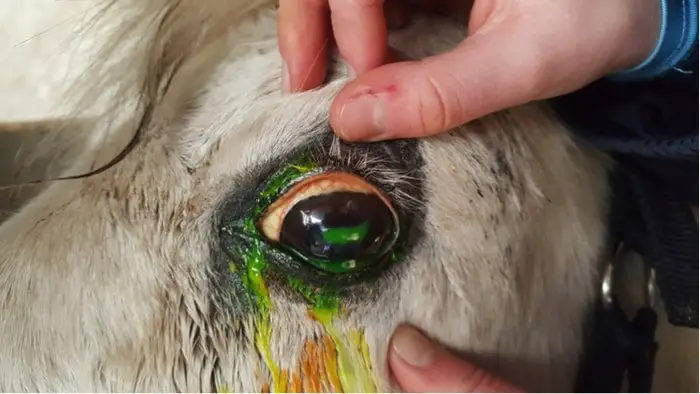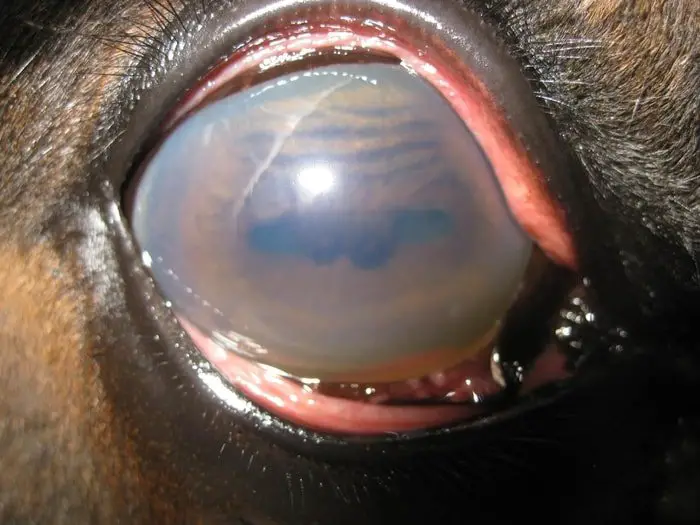Horse Eye problems are important because many of them are very painful conditions and because good sight is vital for all working horses. The safety of the horse and of the rider depends upon good vision. Equine ophthalmology is an important branch of equine veterinary medicine. The knowledge on horse eye and its probable problems will help you keep your lovely horse healthy and working fit.
Horse Eye: Testing of a Horse’s Sight
You cannot ask a horse if it can see something and a blind horse will know its way around a familiar environment. To check a horse’s vision you need to blindfold an eye and lead it into an obstacle course. A horse that has vision problems in the uncovered eye will bump into objects or trip over things on the ground. Do one eye and check the other eye.
A “menace” test can also be used to check vision. In this test, an object such as your finger is moved towards the eye and a blink indicates the horse can see the finger. Do not touch the eyelids, eyelashes or eyeballs and do not move air against the eye when doing the test. All horses should have their vision checked by the buyer’s veterinary surgeon at the time of sale.
Common Eye Conditions of Horse
Horse’s eye is the most sensitive organ of the body. A healthy eye is necessary to keep your horse healthy and riding fit. The most common horse eye problems may arise from infection by bacteria, viruses, fungus, physical injury or even by parasites. For your easy understanding and assimilation, I have accumulated eight most common eye problems of horse for your attention.
1. Ulcers in Horse Eye
This is a condition where the clear front surface of the eyeball (cornea) is damaged and eroded. Ulcers are caused by infections, foreign materials such as chaff or grass seeds in the eye, or by contact to the front of the eyeball- horses that have been struck with a whip in the eye may develop ulcers, for instance.
Ulcers are very painful for the horses and generally, the horse will keep that eyelid partly closed, there will be some discharge from the eye and the ulcer site may be visible. Special stains are needed to outline the area of ulcer. Often the cornea is cloudy.
Most ulcers can be successfully treated and rapidly resolved. Do not use any old eye ointment that you have from treating a previous eye problem, as some eye ointment contains corticosteroids can make ulcers worse. Place the horse in the darkened stable until it has been examined by a vet.
Treatment will principally involve placing a number of eye ointment into the eye every few hours, so it will be quite intensive. In severe cases, a “drip” treatment system can be surgically implanted into the upper eyelid allowing easy treatment.
If left untreated, some ulcers can heal satisfactorily and others will lead to scarring of the eye that may impair vision. Some ulcers will actually lead to rupture of the cornea and loss of sight. This means a corneal ulcer should be treated intensively.
2. Uveitis
This is a condition where the whole eye is inflamed and painful. The cause of uveitis is often unknown, although in some cases it may relate to infection or trauma to the area of the eye.
A horse with uveitis will have a closed eye, some discharge from the corner of the eye, a closed pupil, reddening of the conjunctiva, and often a cloudy cornea. Early and aggressive treatment of this problem is essential if it is to be resolved, although in some cases become recurrent and will flare up after a relatively quiet period. In severe recurrent cases, the horse’s sight in that eye will be threatened.

3. Conjunctivitis
Conjunctivitis is most often seen in summer when dust, flies, and wind irritate the horse’s eye. It is more common in horses with open eyes, where a lot of white (conjunctiva) is exposed and not covered by the eyelids. The horse will show reddening of the conjunctiva and also a discharge from the eye. Usually, both eyes are affected.
Conjunctivitis may resolve itself if the predisposing condition is modified, although some cases need eye ointment therapy. It is desirable to clear up the discharge will attract more flies to the area and irritate the horse.
4. Eyelid Injury of Horse
Although eyelid injury is uncommon, horses sometimes have wounds in the eyelids which require attention. Often these are small but it is important that they are stitched so that a continuous eyelid margin is maintained. If these wounds are not stitched, they will heal but there may be a gap or ledge in the eyelid margin that predispose the eye to other problems such as conjunctivitis or corneal penetration. Skin wound around the head heal very well in comparison to other parts of the horse’s body and repair of an eyelid wound will not generally leave a scar.
5. Horse Eye: Blocked Tear Duct
This problem leads to a continuous discharge from one or both eyes as the normal drainage via the tear duct cannot occur. The tear duct drains the liquid from the inside corner of the eye out into the region of the nostril. This is one reason why horses always have some dampness around their nostrils. If the tear duct is blocked, the liquid will overflow the eyelid margin and run down the side of the horse’s nose. This is unsightly and can attract flies. It is a simple problem to diagnose and treat, involving sedation of the horse and flushing the tear duct.
6. Equine Eye Trauma
Where horses have been knocked or kicked in the area of the eye, the horse may present with swollen eyelids and swelling around the eye, discharge from the eye or marks on the cornea which represents damage to the front surface of the eye. These marks may be blue or white and may show signs of inflammation or scarring.
Because of the uveitis or corneal damage that compromises sight, eyelid trauma should receive prompt veterinary attention. A seemingly minor knock can set up a process that eventually leads to loss of the eye.
7. Equine Cataract
An equine cataract is the opacity of the lens of the horse eye leading to partial or complete blindness. As the age of cataract increases the degree of the opaqueness of lens increases. The foal may get cataract congenitally. Most of the cases, the veterinarian suggested surgical removal of the cataract.

8. Acute Blindness in Horse
There are numerous causes of acute blindness in horses that may felt your trouble. The causes of acute blindness are glaucoma, uveitis, trauma, hemorrhage in eyeballs, optic neuritis, retinal detachment, and CNS diseases. Persistent of any eye problem may lead to permanent blindness and inactive your horse.
Concluding Remarks
As a horse owner or horseback rider, you must check your horse’s eye daily. A regular checkup and care will ensure the health of your horse’s eye. In case of any abnormality or discharge, you must call your vet and take necessary actions. A healthy eye will ensure the safety of both horse and rider.